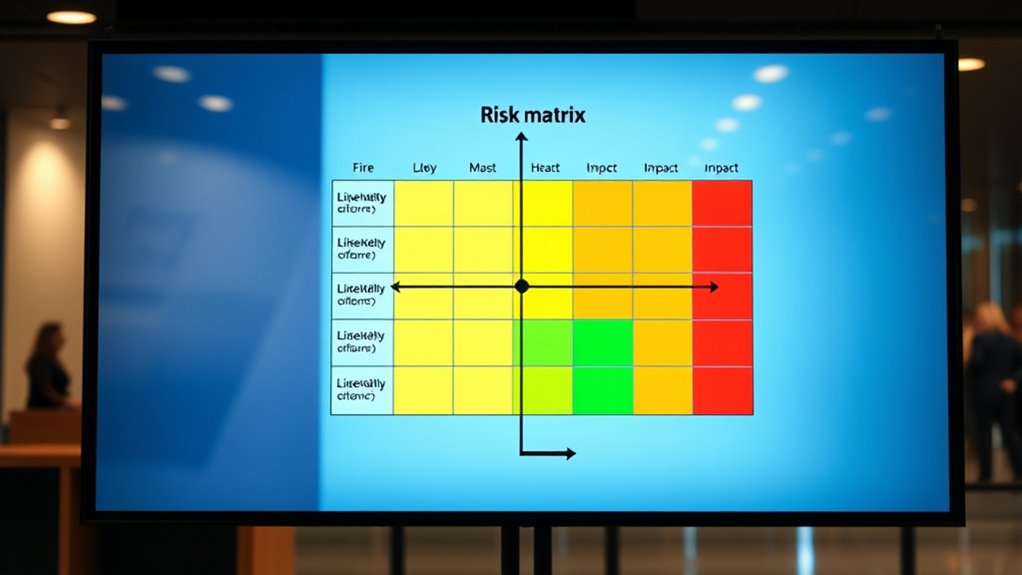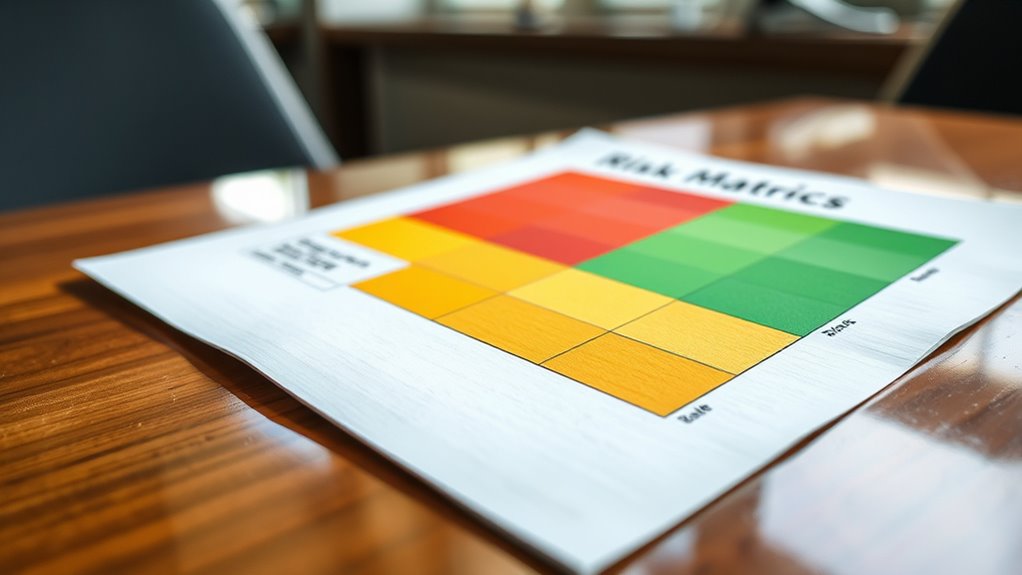Risk matrices are simple visual tools that help you quickly prioritize hazards based on their likelihood and potential impact. By plotting risks on a grid, you can easily identify which hazards require immediate attention and which can be monitored later. They facilitate clear communication and support decision-making in fast-paced situations. Understanding how to effectively use a risk matrix can markedly improve safety efforts — and there’s more to uncover if you keep exploring.
Key Takeaways
- Risk matrices visually organize hazards by likelihood and severity, making complex data easier to interpret quickly.
- They help identify high-priority risks that need immediate mitigation efforts.
- Visual cues like color coding enhance understanding and communication of hazard levels.
- Risk matrices support dynamic decision-making by allowing updates as new information arises.
- They provide serious insights into safety risks, enabling effective resource allocation and risk management.

Have you ever wondered how organizations identify and prioritize potential risks? It’s a vital part of managing safety, operations, and overall decision-making. The process begins with a thorough risk assessment, where you evaluate what could go wrong and how severe the consequences might be. But understanding the risks is just half the battle—you also need a clear way to determine which hazards demand immediate attention. That’s where hazard prioritization comes into play. It helps you decide which risks are most pressing by comparing their likelihood and potential impact.
Risk matrices are invaluable tools in this process. They provide simple, visual ways to organize complex information, making it easier for you to see at a glance which hazards pose the greatest threat. By laying out risks on a grid—usually with axes representing the likelihood of occurrence and the severity of consequences—you can quickly identify which hazards fall into high-priority zones. This visual approach streamlines hazard prioritization, ensuring you focus your resources where they’re needed most.
Risk matrices visually identify and prioritize hazards by plotting likelihood and severity for quick, clear decision-making.
When you use a risk matrix, you start by conducting a thorough risk assessment. You list potential hazards, then estimate their probability and potential impact. These assessments can be based on data, expert judgment, or historical incidents. Once you have this information, you plot each hazard on the matrix. For example, a risk with a high likelihood and severe impact will land in the top-right corner, signaling it’s a top priority. Conversely, low-likelihood, low-impact hazards fall into the bottom-left, indicating they require less immediate attention.
This method not only simplifies hazard prioritization but also enhances communication among team members. A clear visual helps everyone understand which risks are most critical, fostering a shared understanding and supporting consensus on mitigation strategies. It also facilitates quick decision-making, especially in fast-paced environments where time is limited. You can easily adjust the risk matrix as new information emerges or conditions change, keeping your hazard prioritization dynamic and accurate. Incorporating color accuracy considerations from home cinema projectors can improve the clarity and realism of the visual display, aiding in better hazard assessment and communication.
Frequently Asked Questions
How Do Risk Matrices Integrate With Other Risk Management Tools?
You integrate risk matrices with other risk management tools by using them to enhance risk communication and stakeholder engagement. They visually highlight risks, making complex data easier to understand. This helps you facilitate discussions, prioritize actions, and share insights across teams. Combined with tools like risk registers or SWOT analyses, risk matrices create an all-encompassing approach, ensuring everyone stays informed, involved, and aligned on risk mitigation strategies.
What Industries Benefit Most From Using Risk Matrices?
You’ll find that industries like manufacturing and healthcare benefit most from risk matrices. Notably, about 70% of manufacturing companies use them for safety and process improvements, while healthcare relies on these tools to assess patient risks and operational hazards. By visualizing potential threats, you can quickly prioritize actions, making risk matrices essential for managing complex, high-stakes environments in both sectors.
Can Risk Matrices Be Automated Within Project Management Software?
You can definitely automate risk assessment within project management software. By integrating risk matrices into your tools, you streamline the process and improve accuracy. Software integration allows for real-time updates and easy visualization, making it simpler for you to identify and prioritize risks. Automation reduces manual effort and minimizes errors, helping you manage projects more efficiently and make informed decisions quickly.
How Do You Update or Revise a Risk Matrix Over Time?
To update or revise a risk matrix over time, you should regularly conduct risk assessments and gather new data. As your project progresses, reassess the risks, and adjust the matrix accordingly to reflect current realities. This process improves visual clarity and guarantees the matrix provides accurate insights. By consistently reviewing and refining your risk matrix, you keep your risk management proactive, helping you make better-informed decisions throughout the project lifecycle.
What Are Common Pitfalls in Designing Effective Risk Matrices?
When designing effective risk matrices, you risk oversimplification, which can hide important nuances. Be cautious of subjective categorization, where personal biases influence risk levels, leading to inconsistent assessments. Make certain you involve diverse perspectives and establish clear criteria to minimize bias. Avoid creating a matrix that’s too simplistic or vague, as it can mislead decision-making. Strive for a balanced, well-defined approach that accurately reflects real risks without losing essential details.
Conclusion
Risk matrices are your compass in a stormy sea, guiding you through turbulent waters with clarity and confidence. They transform chaos into order, turning complex threats into manageable steps. By harnessing these simple visuals, you equip yourself with a lighthouse that shines through fog and darkness. Remember, a well-placed risk matrix doesn’t just map hazards—it illuminates your path, helping you navigate uncertainties with steady resolve and strategic foresight.









